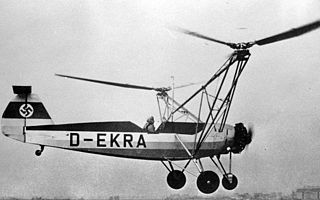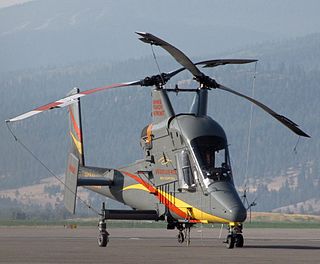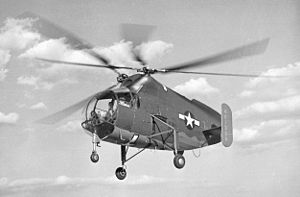
The Focke-Wulf Fw 61 is often considered the first practical, functional helicopter, first flown in 1936. It was also known as the Fa 61, as Focke began a new company—Focke-Achgelis—in 1937.

The Boeing–Sikorsky RAH-66 Comanche is an American stealth armed reconnaissance and attack helicopter designed for the United States Army. Following decades of study and development, the RAH-66 program was canceled in 2004 before mass production began, by which point nearly US$7 billion had been spent on the program.

The Sikorsky S-67 Blackhawk was a private-venture, prototype attack helicopter built in 1970 with Sikorsky Aircraft research and development (R&D) funds. A tandem, two-seat aircraft designed around the dynamic drive and rotor systems of the Sikorsky S-61, it was designed to serve as an attack helicopter or to transport up to eight troops into combat.

The Kaman HH-43 Huskie is a helicopter developed and produced by the American rotorcraft manufacturer Kaman Aircraft. It is perhaps most distinctive for its use of twin intermeshing rotors, having been largely designed by the German aeronautical engineer Anton Flettner.

The Sikorsky R-4 is a two-seat helicopter that was designed by Igor Sikorsky with a single, three-bladed main rotor and powered by a radial engine. The R-4 was the world's first large-scale mass-produced helicopter and the first helicopter used by the United States Army Air Forces, the United States Navy, the United States Coast Guard and the United Kingdom's Royal Air Force and Royal Navy. In U.S. Navy and U.S. Coast Guard service, the helicopter was known as the Sikorsky HNS-1. In British service it was known as the Hoverfly.

The Hughes XH-17 "Flying Crane" was the first helicopter project for the helicopter division of Hughes Aircraft Company. The XH-17, which had a two-bladed main rotor system with a diameter of 134 feet, still holds the world record for flying with the largest rotor system. It was capable of flying at a gross weight of more than 50,000 pounds (23,000 kg), but proved too inefficient and cumbersome to be mass-produced beyond the prototype unit.

The Flettner Fl 282 Kolibri (Hummingbird) is a single-seat intermeshing rotor helicopter, or synchropter, produced by Anton Flettner of Germany. According to Yves Le Bec, the Flettner Fl 282 was the world's first series production helicopter.

The Westland WS-51 Dragonfly helicopter was built by Westland Aircraft and was an Anglicised licence-built version of the American Sikorsky S-51.

An intermeshing-rotor helicopter is a helicopter with a set of two main rotors turning in opposite directions, with each rotor mast mounted with a slight angle to the other, in a transversely symmetrical manner, so that the blades intermesh without colliding. The arrangement allows the helicopter to function without a tail rotor, which saves power. However, neither rotor lifts directly vertically, which reduces efficiency per each rotor.

The Sikorsky X2 is an experimental high-speed compound helicopter with coaxial rotors, developed by Sikorsky Aircraft, that made its first flight in 2008 and was officially retired in 2011.

The Cierva W.11 Air Horse was a helicopter developed by the Cierva Autogiro Company in the United Kingdom during the mid-1940s. The largest helicopter in the world at the time of its debut, the Air Horse was unusual for using three rotors mounted on outriggers, and driven by a single engine mounted inside the fuselage.

The Fairey FB-1 Gyrodyne is an experimental British rotorcraft that used single lifting rotor and a tractor propeller mounted on the tip of the starboard stub wing to provide both propulsion and anti-torque reaction.

The Platt-LePage XR-1, also known by the company designation PL-3, was an early American transverse rotors helicopter, built by the Platt-LePage Aircraft Company of Eddystone, Pennsylvania. The winner of a United States Army Air Corps design competition held in early 1940, the XR-1 was the first helicopter tested by the USAAF, flying in 1941. The flight testing of the XR-1 proved troublesome, and although continued testing showed that the design had promise, other, improved helicopters were becoming available before the XR-1 was ready for service. As a result, the development of the aircraft was terminated in 1945.

The Doman LZ-5 was a utility helicopter developed in the United States in the early 1950s by Doman Helicopters Inc. of Danbury, Connecticut. Despite the procurement of international manufacturing agreements, no series production of the aircraft ever occurred, and only three prototypes were built. Two of these were purchased by the United States Army as the YH-31, but eventually becoming VH-31.

The Kellett KD-1 was a 1930s American autogyro built by the Kellett Autogiro Company. It had the distinction of being the first practical rotary-wing aircraft used by the United States Army and inaugurated the first scheduled air-mail service using a rotary-wing aircraft.

The Sikorsky XH-39, developed by Sikorsky Aircraft in 1954, was the U.S. Army's first turbine-powered helicopter. It was fast and innovative, but ultimately rejected by the United States Army in favor of the Bell UH-1 Iroquois.

The Sikorsky S-52 is a utility helicopter developed by Sikorsky Aircraft in the late 1940s. It was used by the U.S. Navy, Marine Corps, and Coast Guard. The S-52 was the first US helicopter with all-metal rotor blades. Initially a two-seater, it was developed into the four-seat S-52-2 and S-52-3. It was designated HO5S-1 by the U.S. Navy and Marine Corps, HO5S-1G by the Coast Guard, and YH-18A by the U.S. Army, and was used extensively by civil operators after being retired by the military.

The Kellett XR-10 was a military transport helicopter developed in the United States in the 1940s that only flew in prototype form. It was designed in response to a USAAF Technical Instruction issued for the development of a helicopter to transport passengers, cargo, or wounded personnel within an enclosed fuselage. Kellett's proposal followed the general layout that the company was developing in the XR-8, with twin intermeshing rotors, and was accepted by the Air Force on 16 October over proposals by Sikorsky, Bell, and Platt-LePage.

The Sikorsky R-6 is an American light two-seat helicopter of the 1940s. In Royal Air Force and Royal Navy service, it was named the Hoverfly II.

The SNCAC NC.2001 Abeille was a single engine, twin intermeshing rotor helicopter designed and built in France in the late 1940s. Three were completed but only one flew, development ending when SNCAC was closed.




















